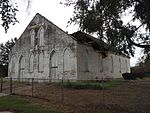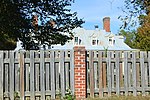Mayfield Cottage
Central Virginia Registered Historic Place stubsColonial architecture in VirginiaHistoric American Buildings Survey in VirginiaHouses completed in 1750Houses in Dinwiddie County, Virginia ... and 3 more
Houses on the National Register of Historic Places in VirginiaNational Register of Historic Places in Dinwiddie County, VirginiaPlantation houses in Virginia

Mayfield Cottage is a historic plantation house located near the grounds of Central State Hospital near Petersburg, Dinwiddie County, Virginia. Believed to be the oldest existing brick house in Dinwiddie County, it was built around 1750 and the residence of Robert Ruffin until 1769, when he moved to King William County. From 1885, the property was used by the hospital for its headquarters. The house remained part of the hospital complex until 1969. It was moved from its original site about .5 miles (0.80 km) to the southeast of the present site in 1969.
Excerpt from the Wikipedia article Mayfield Cottage (License: CC BY-SA 3.0, Authors, Images).Mayfield Cottage
West Washington Street, Petersburg
Geographical coordinates (GPS) Address Phone number Website Nearby Places Show on map
Geographical coordinates (GPS)
| Latitude | Longitude |
|---|---|
| N 37.213888888889 ° | E -77.447777777778 ° |
Address
Central State Hospital
West Washington Street 26317
23803 Petersburg
Virginia, United States
Open on Google Maps










